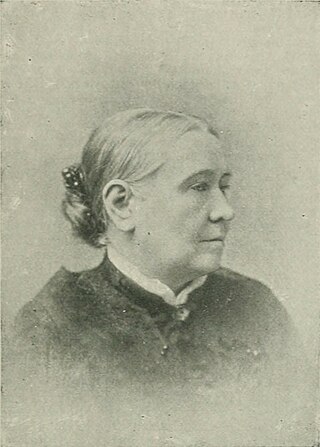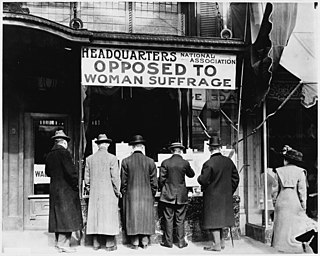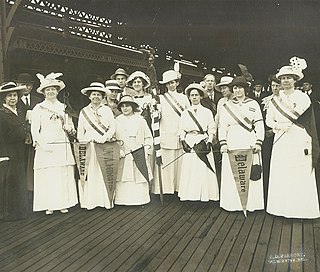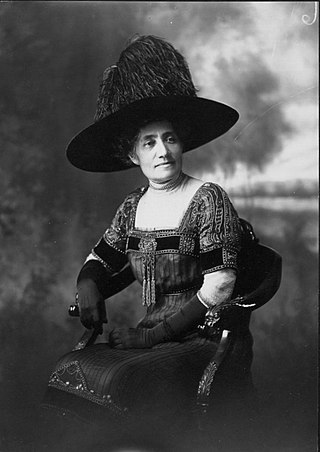
The Nineteenth Amendment to the United States Constitution prohibits the United States and its states from denying the right to vote to citizens of the United States on the basis of sex, in effect recognizing the right of women to vote. The amendment was the culmination of a decades-long movement for women's suffrage in the United States, at both the state and national levels, and was part of the worldwide movement towards women's suffrage and part of the wider women's rights movement. The first women's suffrage amendment was introduced in Congress in 1878. However, a suffrage amendment did not pass the House of Representatives until May 21, 1919, which was quickly followed by the Senate, on June 4, 1919. It was then submitted to the states for ratification, achieving the requisite 36 ratifications to secure adoption, and thereby go into effect, on August 18, 1920. The Nineteenth Amendment's adoption was certified on August 26, 1920.

Women's suffrage, or the right to vote, was established in the United States over the course of more than half a century, first in various states and localities, sometimes on a limited basis, and then nationally in 1920 with the ratification of the 19th Amendment to the United States Constitution.

Anti-suffragism was a political movement composed of both men and women that began in the late 19th century in order to campaign against women's suffrage in countries such as Australia, Canada, Ireland, the United Kingdom and the United States. To some extent, Anti-suffragism was a Classical Conservative movement that sought to keep the status quo for women. More American women organized against their own right to vote than in favor of it, until 1916. Anti-suffragism was associated with "domestic feminism," the belief that women had the right to complete freedom within the home. In the United States, these activists were often referred to as "remonstrants" or "antis."
This timeline highlights milestones in women's suffrage in the United States, particularly the right of women to vote in elections at federal and state levels.

Women's suffrage was established in the United States on a full or partial basis by various towns, counties, states and territories during the latter decades of the 19th century and early part of the 20th century. As women received the right to vote in some places, they began running for public office and gaining positions as school board members, county clerks, state legislators, judges, and, in the case of Jeannette Rankin, as a member of Congress.

Madeleine Vinton Dahlgren was an American writer, translator, and anti-suffragist. Her volume, Idealities was her first work in book form. Thereafter, she found time to write upon a great variety of subjects. She made several translations from the French, Spanish and Italian languages, notably Charles Forbes René de Montalembert's brochure, "Pius IX," the abstruse philosophical work of Juan Donoso Cortés from the Spanish, and the monograph of Adolphe de Chambrun on "The Executive Power". These translations brought her positive recognitions, among others, a flattering letter from Montalembert. She was the author of a voluminous Biography of Admiral Dahlgren, and a number of novels including South-Mountain Magic, A Washington Winter, The Lost Name, Lights and Shadows of a Life, Divorced, South Sea Sketches (Boston), and a volume on Etiquette of Social Life in Washington, Thoughts on Female Suffrage, and also of a great number of essays, articles, reviews and short stories written for papers and periodicals. Occasionally, Dahlgren expressed herself in verse, and several of her efforts are included in anthologies of poets.

The National Association Opposed to Women Suffrage (NAOWS) was founded in the United States by women opposed to the suffrage movement in 1911. It was the most popular anti-suffrage organization in northeastern cities. NAOWS had influential local chapters in many states, including Texas and Virginia.

The Connecticut Woman Suffrage Association (CWSA) was founded on October 28, 1869, by Isabella Beecher Hooker and Frances Ellen Burr at Connecticut's first suffrage convention. Its main goal was to persuade the Connecticut General Assembly to ratify the 19th amendment, giving women in Connecticut the right to vote. Throughout its 52 years of existence, the CWSA helped to pass local legislation and participated in the national fight for women's suffrage. It cooperated with the National Women's Suffrage Association through national protests and demonstrations. As well as advocating for women's suffrage, this association was active in promoting labor regulations, debating social issues, and fighting political corruption.

The New York State Association Opposed to Woman Suffrage (NYSAOWS) was an American anti-suffrage organization in New York. The group was made up of prominent women who fought against the cause of women's suffrage by giving speeches, handing out materials and pamphlets and also publishing a journal. There were several auxiliaries of the group throughout New York and it was considered one of the most active anti-suffrage groups in the state.

Women's suffrage was granted in Virginia in 1920, with the ratification of the Nineteenth Amendment to the United States Constitution. The General Assembly, Virginia's governing legislative body, did not ratify the Nineteenth Amendment until 1952. The argument for women's suffrage in Virginia began in 1870, but it did not gain traction until 1909 with the founding of the Equal Suffrage League of Virginia. Between 1912 and 1916, Virginia's suffragists would bring the issue of women's voting rights to the floor of the General Assembly three times, petitioning for an amendment to the state constitution giving women the right to vote; they were defeated each time. During this period, the Equal Suffrage League of Virginia and its fellow Virginia suffragists fought against a strong anti-suffragist movement that tapped into conservative, post-Civil War values on the role of women, as well as racial fears. After achieving suffrage in August 1920, over 13,000 women registered within one month to vote for the first time in the 1920 United States presidential election.

The women's suffrage movement was active in Missouri mostly after the Civil War. There were significant developments in the St. Louis area, though groups and organized activity took place throughout the state. An early suffrage group, the Woman Suffrage Association of Missouri, was formed in 1867, attracting the attention of Susan B. Anthony and leading to news items around the state. This group, the first of its kind, lobbied the Missouri General Assembly for women's suffrage and established conventions. In the early 1870s, many women voted or registered to vote as an act of civil disobedience. The suffragist Virginia Minor was one of these women when she tried to register to vote on October 15, 1872. She and her husband, Francis Minor, sued, leading to a Supreme Court case that asserted the Fourteenth Amendment granted women the right to vote. The case, Minor v. Happersett, was decided against the Minors and led suffragists in the country to pursue legislative means to grant women suffrage.

The women's suffrage movement in Montana started while it was still a territory. The Women's Christian Temperance Union (WCTU) was an early organizer that supported suffrage in the state, arriving in 1883. Women were given the right to vote in school board elections and on tax issues in 1887. When the state constitutional convention was held in 1889, Clara McAdow and Perry McAdow invited suffragist Henry Blackwell to speak to the delegates about equal women's suffrage. While that proposition did not pass, women retained their right to vote in school and tax elections as Montana became a state. In 1895, National American Woman Suffrage Association (NAWSA) came to Montana to organize local groups. Montana suffragists held a convention and created the Montana Woman's Suffrage Association (MWSA). Suffragists continued to organize, hold conventions and lobby the Montana Legislature for women's suffrage through the end of the nineteenth century. In the early twentieth century, Jeannette Rankin became a driving force around the women's suffrage movement in Montana. By January 1913, a women's suffrage bill had passed the Montana Legislature and went out as a referendum. Suffragists launched an all-out campaign leading up to the vote. They traveled throughout Montana giving speeches and holding rallies. They sent out thousands of letters and printed thousands of pamphlets and journals to hand out. Suffragists set up booths at the Montana State Fair and they held parades. Finally, after a somewhat contested election on November 3, 1914, the suffragists won the vote. Montana became one of eleven states with equal suffrage for most women. When the Nineteenth Amendment was passed, Montana ratified it on August 2, 1919. It wasn't until 1924 with the passage of the Indian Citizenship Act that Native American women gained the right to vote.

The first women's suffrage group in Georgia, the Georgia Woman Suffrage Association (GWSA), was formed in 1892 by Helen Augusta Howard. Over time, the group, which focused on "taxation without representation" grew and earned the support of both men and women. Howard convinced the National American Women's Suffrage Association (NAWSA) to hold their first convention outside of Washington, D.C., in 1895. The convention, held in Atlanta, was the first large women's rights gathering in the Southern United States. GWSA continued to hold conventions and raise awareness over the next years. Suffragists in Georgia agitated for suffrage amendments, for political parties to support white women's suffrage and for municipal suffrage. In the 1910s, more organizations were formed in Georgia and the number of suffragists grew. In addition, the Georgia Association Opposed to Woman Suffrage also formed an organized anti-suffrage campaign. Suffragists participated in parades, supported bills in the legislature and helped in the war effort during World War I. In 1917 and 1919, women earned the right to vote in primary elections in Waycross, Georgia and in Atlanta respectively. In 1919, after the Nineteenth Amendment went out to the states for ratification, Georgia became the first state to reject the amendment. When the Nineteenth Amendment became the law of the land, women still had to wait to vote because of rules regarding voter registration. White Georgia women would vote statewide in 1922. Native American women and African-American women had to wait longer to vote. Black women were actively excluded from the women's suffrage movement in the state and had their own organizations. Despite their work to vote, Black women faced discrimination at the polls in many different forms. Georgia finally ratified the Nineteenth Amendment on February 20, 1970.

Women's suffrage began in Delaware the late 1860s, with efforts from suffragist, Mary Ann Sorden Stuart, and an 1869 women's rights convention held in Wilmington, Delaware. Stuart, along with prominent national suffragists lobbied the Delaware General Assembly to amend the state constitution in favor of women's suffrage. Several suffrage groups were formed early on, but the Delaware Equal Suffrage Association (DESA) formed in 1896, would become one of the major state suffrage clubs. Suffragists held conventions, continued to lobby the government and grow their movement. In 1913, a chapter of the Congressional Union (CU), which would later be known at the National Woman's Party (NWP), was set up by Mabel Vernon in Delaware. NWP advocated more militant tactics to agitate for women's suffrage. These included picketing and setting watchfires. The Silent Sentinels protested in Washington, D.C., and were arrested for "blocking traffic." Sixteen women from Delaware, including Annie Arniel and Florence Bayard Hilles, were among those who were arrested. During World War I, both African-American and white suffragists in Delaware aided the war effort. During the ratification process for the Nineteenth Amendment, Delaware was in the position to become the final state needed to complete ratification. A huge effort went into persuading the General Assembly to support the amendment. Suffragists and anti-suffragists alike campaigned in Dover, Delaware for their cause. However, Delaware did not ratify the Nineteenth Amendment until March 6, 1923, well after it was already part of the United States Constitution.

Women's suffrage began in Hawaii in the 1890s. However, when the Hawaiian Kingdom ruled, women had roles in the government and could vote in the House of Nobles. After the overthrow of Queen Liliʻuokalani in 1893, women's roles were more restricted. Suffragists, Wilhelmine Kekelaokalaninui Widemann Dowsett and Emma Kaili Metcalf Beckley Nakuina, immediately began working towards women's suffrage. The Women's Christian Temperance Union (WCTU) of Hawaii also advocated for women's suffrage in 1894. As Hawaii was being annexed as a US territory in 1899, racist ideas about the ability of Native Hawaiians to rule themselves caused problems with allowing women to vote. Members of the National American Woman Suffrage Association (NAWSA) petitioned the United States Congress to allow women's suffrage in Hawaii with no effect. Women's suffrage work picked up in 1912 when Carrie Chapman Catt visited Hawaii. Dowsett created the National Women's Equal Suffrage Association of Hawai'i that year and Catt promised to act as the delegate for NAWSA. In 1915 and 1916, Prince Jonah Kūhiō Kalanianaʻole brought resolutions to the U.S. Congress requesting women's suffrage for Hawaii. While there were high hopes for the effort, it was not successful. In 1919, suffragists around Hawaii met for mass demonstrations to lobby the territorial legislature to pass women's suffrage bills. These were some of the largest women's suffrage demonstrations in Hawaii, but the bills did not pass both houses. Women in Hawaii were eventually franchised through the passage of the Nineteenth Amendment.

While women's suffrage had an early start in Maine, dating back to the 1850s, it was a long, slow road to equal suffrage. Early suffragists brought speakers Susan B. Anthony and Lucy Stone to the state in the mid-1850s. Ann F. Jarvis Greely and other women in Ellsworth, Maine, created a women's rights lecture series in 1857. The first women's suffrage petition to the Maine Legislature was also sent that year. Working-class women began marching for women's suffrage in the 1860s. The Snow sisters created the first Maine women's suffrage organization, the Equal Rights Association of Rockland, in 1868. In the 1870s, a state suffrage organization, the Maine Women's Suffrage Association (MWSA), was formed. Many petitions for women's suffrage were sent to the state legislature. MWSA and the Woman's Christian Temperance Union (WCTU) of Maine worked closely together on suffrage issues. By the late 1880s the state legislature was considering several women's suffrage bills. While women's suffrage did not pass, during the 1890s many women's rights laws were secured. During the 1900s, suffragists in Maine continued to campaign and lecture on women's suffrage. Several suffrage organizations including a Maine chapter of the College Equal Suffrage League and the Men's Equal Rights League were formed in the 1910s. Florence Brooks Whitehouse started the Maine chapter of the National Woman's Party (NWP) in 1915. Suffragists and other clubwomen worked together on a large campaign for a 1917 voter referendum on women's suffrage. Despite the efforts of women around the state, women's suffrage failed. Going into the next few years, a women's suffrage referendum on voting in presidential elections was placed on the September 13, 1920 ballot. But before that vote, Maine ratified the Nineteenth Amendment on November 5, 1920. It was the nineteenth state to ratify. A few weeks after ratification, MWSA dissolved and formed the League of Women Voters (LWV) of Maine. White women first voted in Maine on September 13, 1920. Native Americans in Maine had to wait longer to vote. In 1924, they became citizens of the United States. However, Maine would not allow individuals living on Indian reservations to vote. It was not until the passage of a 1954 equal rights referendum that Native Americans gained the right to vote in Maine. In 1955 Lucy Nicolar Poolaw (Penobscot) was the first Native American living on a reservation in Maine to cast a vote.

Attempts to secure women's suffrage in Wisconsin began before the Civil War. In 1846, the first state constitutional convention delegates for Wisconsin discussed women's suffrage and the final document eventually included a number of progressive measures. This constitution was rejected and a more conservative document was eventually adopted. Wisconsin newspapers supported women's suffrage and Mathilde Franziska Anneke published the German language women's rights newspaper, Die Deutsche Frauen-Zeitung, in Milwaukee in 1852. Before the war, many women's rights petitions were circulated and there was tentative work in forming suffrage organizations. After the Civil War, the first women's suffrage conference held in Wisconsin took place in October 1867 in Janesville. That year, a women's suffrage amendment passed in the state legislature and waited to pass the second year. However, in 1868 the bill did not pass again. The Wisconsin Woman Suffrage Association (WWSA) was reformed in 1869 and by the next year, there were several chapters arranged throughout Wisconsin. In 1884, suffragists won a brief victory when the state legislature passed a law to allow women to vote in elections on school-related issues. On the first voting day for women in 1887, the state Attorney General made it more difficult for women to vote and confusion about the law led to court challenges. Eventually, it was decided that without separate ballots, women could not be allowed to vote. Women would not vote again in Wisconsin until 1902 after separate school-related ballots were created. In the 1900s, state suffragists organized and continued to petition the Wisconsin legislature on women's suffrage. By 1911, two women's suffrage groups operated in the state: WWSA and the Political Equality League (PEL). A voter referendum went to the public in 1912. Both WWSA and PEL campaigned hard for women's equal suffrage rights. Despite the work put in by the suffragists, the measure failed to pass. PEL and WWSA merged again in 1913 and women continued their education work and lobbying. By 1915, the National Woman's Party also had chapters in Wisconsin and several prominent suffragists joined their ranks. The National Woman Suffrage Association (NAWSA) was also very present in Wisconsin suffrage efforts. Carrie Chapman Catt worked hard to keep Wisconsin suffragists on the path of supporting a federal woman's suffrage amendment. When the Nineteenth Amendment went out to the states for ratification, Wisconsin an hour behind Illinois on June 10, 1919. However, Wisconsin was the first to turn in the ratification paperwork to the State Department.

Women's suffrage started in South Dakota when it was part of Dakota Territory. Prior to 1889, it had a shared history of women's suffrage with North Dakota. While South Dakota was part of the territory, women earned the right to vote on school related issues. They retained this right after it became a separate state. The state constitution specified that there would be a women's suffrage amendment referendum in 1890. Despite a large campaign that included Susan B. Anthony and a state suffrage group, the South Dakota Equal Suffrage Association (SDESA), the referendum failed. The state legislature passed additional suffrage referendums over the years, but each was voted down until 1918. South Dakota was an early ratifier of the Nineteenth Amendment, which was approved during a special midnight legislative session on December 4, 1919.

This is a timeline of women's suffrage in South Dakota. The early history of women's suffrage in the state is shared with North Dakota. When South Dakota became a state, it held a voter referendum in 1890 on an equal suffrage amendment. This effort failed, but suffragists continued to organize and lobby the legislature to pass voter referendums. None passed until 1918. South Dakota ratified the Nineteenth Amendment on December 4, 1919.
Mary Kilbreth was an American anti-suffragist and an active member of the Daughters of the American Revolution. She became president of the New York State Association Opposed to Woman Suffrage (NAOWS) in 1919.


















